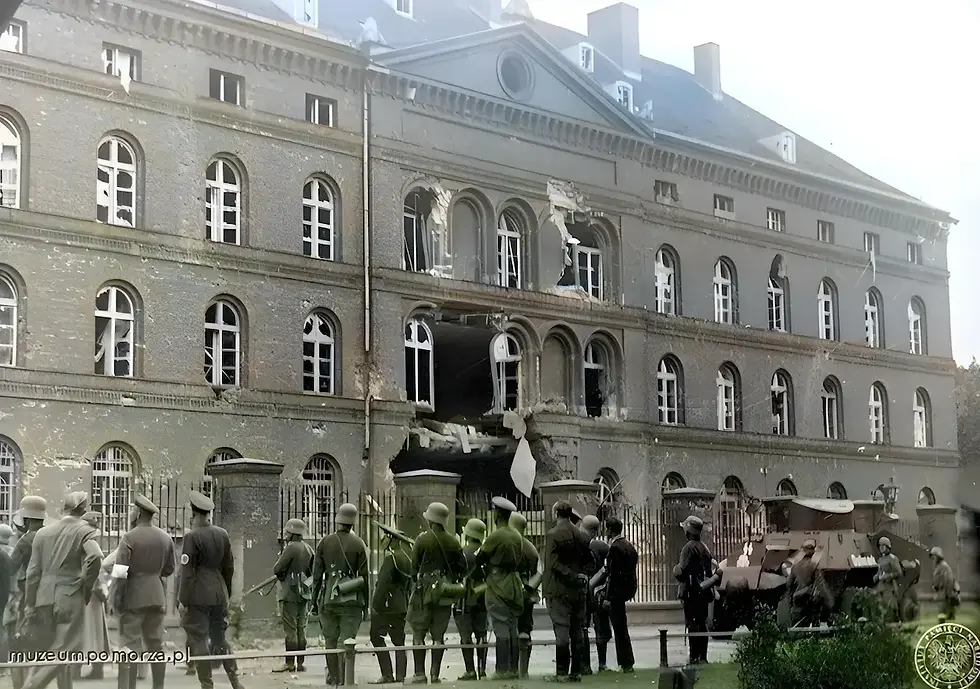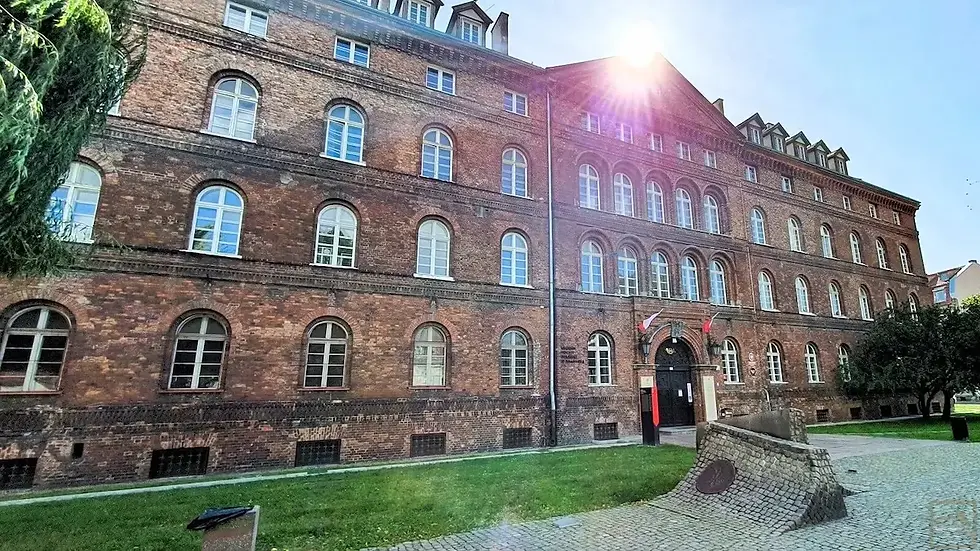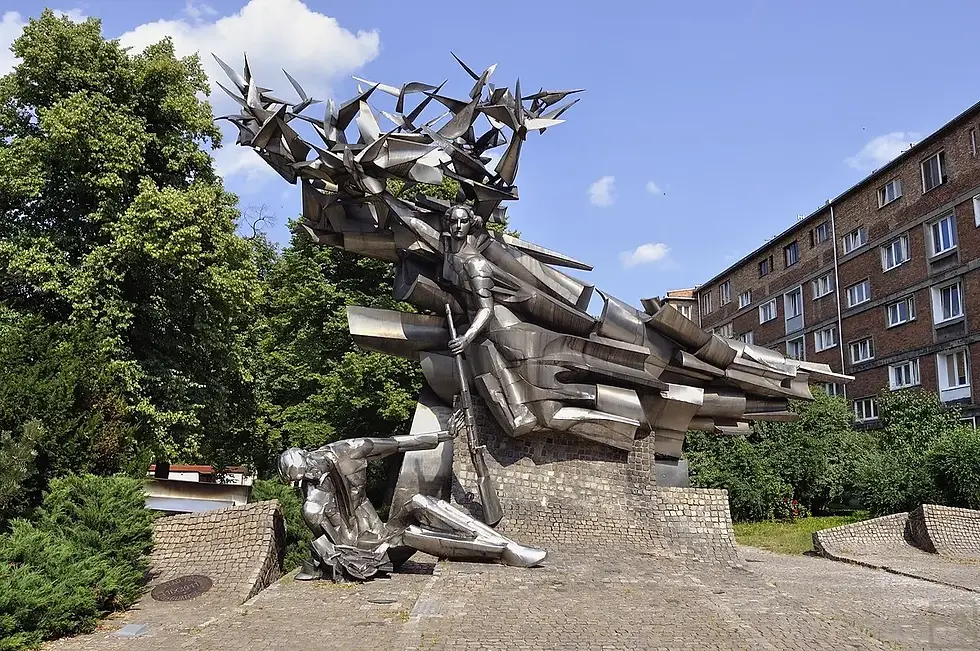The Polish Post Museum in Gdańsk: history, memory and future
- Damian Brzeski

- Jul 30
- 11 min read
Updated: Nov 25
Can a single building tell the story of courage, tragedy, and the identity of an entire nation? The Polish Post Museum in Gdańsk—the site where civilian workers' heroic resistance against the German invader began on September 1, 1939—is more than just a space of remembrance.
It's the heart of dramatic events, a story of the twenty-year struggle of Poles in the Free City of Gdańsk, and a modern institution that will soon speak to visitors in a new, moving language. What awaits visitors after its opening in 2026?

I invite you to the Museum dedicated to the Post Office and Postmen
In the urban fabric of Gdańsk, there are places with a special resonance – symbolic places whose meaning goes far beyond the walls.
One of them, next to Westerplatte, is the building at Obrońców Poczty Polskiej Square.
It was here, in the first hours of World War II, that civilian employees of the Polish facility put up heroic resistance against regular units of the German police and SS.
The Polish Post Museum in Gdańsk, located in this building today, is not only a tourist attraction.
It is a sanctuary of memory, a testimony to courage in the face of totalitarianism, and a center for reflection on the price of loyalty.
Its story, intertwined with the fate of Poles in the Free City of Gdańsk , tells not just about one day, but about two decades of struggle for identity.
Today, in the face of an ambitious modernization, the museum is preparing to tell this story anew, using the language of the 21st century.
The importance and history of the Polish Post Museum
To fully understand the mission of a museum, one must delve into the history of the place where it is located.
It is a story about a land that for centuries witnessed the struggle for Polish presence on the Motława River, and about a building that became its symbol at a tragic moment of historical trial.
The role of the museum in commemorating the defense of September 1, 1939
The fundamental mission of the Polish Post Museum, a branch of the Gdańsk Museum, is to cultivate the memory of the heroic defense of the Polish Post and Telegraph Office on 1 September 1939 and the fate of the defenders themselves and their families.
This facility is one of the key places of national remembrance, documenting the course of the battles that, alongside the attack on Westerplatte, started World War II.
The museum's role, however, extends beyond the act of armed resistance itself. Its mandate encompasses a much broader context – presenting the patriotic and social activities of the Polish community in the Free City of Danzig between 1920 and 1939 .
The duality of the narrative makes the institution unique. The museum tells not only about the soldier's deed, but also about the attitude of an entire community for which the Polish Post Office was the last bastion of Polishness.
The building of the former Polish Post and Telegraph Office No. 1
The building itself is a silent witness to history and a unique exhibit.
The site's profound history: The building rises in the historic Old Town area, known as the Castle . In the Middle Ages, this was the site of a stronghold for Polish governors, and later a Teutonic castle. Demolished by the people of Gdańsk in 1454, it left a desolate square for centuries. This continuity of settlement gives the museum's location an additional, symbolic dimension.
Prussian Origins and a Polish Outpost: The current building was constructed between 1838 and 1844 as a Prussian garrison hospital. After World War I, under the Treaty of Versailles , the northern wing of the building was ceded to Poland. On January 5, 1925, the Polish Post and Telegraph Office Gdańsk 1 officially opened here – a key facility with direct telephone and telegraph connections to Poland.
Destruction and reconstruction: The building, which survived the siege of 1939, was set on fire and destroyed by the Red Army in 1945. It was rebuilt in 1951 and designated as a Telecommunications Technical School. In 1967, the building was added to the register of historic monuments.
The history of the building is a metaphor for the fate of Gdańsk – from a princely castle, through a Teutonic fortress, a Prussian hospital, a symbol of Polishness, a battlefield, to a museum.
The museum is a branch of the Gdańsk Museum.
The institution in its current form was established on September 1, 1979 , on the 40th anniversary of the outbreak of World War II. Since 2003, the Polish Post Museum has operated as a branch of the Gdańsk Museum , providing it with professional facilities.
The partnership with Poczta Polska SA is also extremely important, as it supports the facility financially and helps in acquiring valuable souvenirs.

Defense of the Polish Post Office on September 1, 1939
The drama that unfolded within the building's walls is one of the most heroic and tragic episodes of the September Campaign. It is a story of the unequal struggle of civilians against the war machine of the Third Reich.
The course of the fighting and its symbolic meaning
Defense Preparations: In the spring of 1939, Reserve Second Lieutenant Konrad Guderski was dispatched to Gdańsk to organize the defense. The modest armament consisted of three light machine guns, approximately 40 pistols, rifles, and grenades. The orders were clear: hold the building for six hours until relief arrived.
German attack plan: The attack by 150 police and SS forces, supported by three armored cars, began at 4:45 a.m. , almost simultaneously with the shelling of Westerplatte.
Heroic Resistance: The approximately 50-man postal crew put up an incredibly stubborn resistance. The Germans, surprised by the defenders' determination, brought in artillery and began a methodical bombardment.
The final hours and the crime after the surrender: After nearly 14 hours of fighting, the Germans broke into part of the building, forcing the survivors into the basement. They then pumped gasoline inside and set it on fire . Around 7:00 PM, the defenders decided to surrender. However, the surrender was a prelude to a massacre. The first two people to emerge with a white flag – Director Dr. Jan Michoń and Commander Józef Wąsik – were brutally murdered.
The balance: Eight defenders were killed during the fighting, and six more died in hospital. The remaining 38 postal workers were court-martialed and sentenced to death for "partisan activity." The sentence was carried out on October 5, 1939, in Zaspa.
The defense of the Polish Post Office became a powerful symbol of Polish resistance – a story of the courage of ordinary people who took up the fight to defend their honor and a piece of Polish land.
Heroes of the defense: Konrad Guderski and Józef Wąsik
While each defender is a hero, history has particularly highlighted the figures of the commanders.
Second Lieutenant Konrad Guderski (codename "Konrad"): An intelligence officer assigned to organize the defense. He conducted secret training and developed the operational plan. He was one of the first to die at the very beginning of the fighting.
Commander Józef Wąsik: As one of the highest-ranking officials, he became the natural leader of the civilian staff. His fate is a tragic testament to German brutality – after the announcement of surrender, he was burned alive with a flamethrower.
Alfons Flisykowski: After Guderski's death, he took over command of the defense. After the capitulation, he managed to escape, but was captured and shot on October 5, 1939.
Name and surname | Role | Moose |
Second Lieutenant Konrad Guderski | Military commander of defense | He died in combat on September 1, 1939. |
Alfons Flisykowski | Deputy Commander | Captured on September 2; shot on October 5, 1939 |
Dr. Jan Michoń | Acting Director of the Post and Telegraph Directorate | Shot during the surrender on September 1, 1939 |
Józef Wasik | Head of the Post and Telegraph Office | Burned alive during the surrender on September 1, 1939 |
A replica of a cannon and exhibits from the 1991 exhumation
Museum narrative is based on the power of authentic objects.
Gun Replica: One of the most striking exhibits is a full-scale replica of the German 75mm LIG-18 light infantry gun . Its presence gives an idea of the scale of the force the defenders faced.
Exhibits from the exhumation: The heart of the exhibition, however, are the objects recovered from the mass grave of postal workers, discovered in Zaspa on August 28, 1991. These small, personal items – a gold wedding ring, glasses, medallions, and above all, a uniform button with a bullet hole – have extraordinary power.
The juxtaposition of the impersonal murder weapon with the deeply personal mementos of the victims creates an extremely strong contrast in which the drama of defense resonates most fully.

Poles in the Free City of Danzig
The heroic defense of the postal workers was not an act of desperation. It was the tragic culmination of a twenty-year struggle by the entire Polish community to preserve its identity in a Free City dominated by German nationalism.
Everyday life and social activities of Poles
The Polish community, constituting approximately 10% of the population , has created a kind of "state within a state" – a network of social, cultural and economic institutions.
This was a response to harassment and growing hostility, especially after the Nazis came to power in 1933.
Despite the tensions, Polish life flourished—Polish choirs, theaters, banks, and cooperatives were founded. It was a world built on defiance, an island of Polishness in a sea of Germanic influence.
Polish diaspora organizations: Union of Poles, Gdańsk School Association, Gedania
The backbone of Polish life were dynamic organizations.
The Polish Community Union of Poles: Established in 1937 through the merger of two smaller organizations, it became a powerful, united representation of the Polish diaspora in the face of a growing threat.
Gdańska Macierz Szkolna: Arguably the most important Polish organization, founded in 1921. Its goal was to protect children from Germanization by creating a complete Polish education system – from kindergarten to the prestigious Polish Gymnasium.
Gedania Sports Club : Founded in 1922, Gedania was more than just a sports club. It was a vibrant center of Polish youth activity. Its matches against German teams took on the character of national duels. Many defenders of the Post Office were its members.
The postmen weren't just defending a building. They were defending a symbol of their entire world – Polish schools, clubs, choirs, and associations.
The main exhibition spaces of the museum
This description combines the state of the exhibition before modernization with a vision of what will be created in 2026.
Post Office Hall: reconstruction of the pre-war facility
Before its modernization, this space recreated the atmosphere of a post office from the interwar period. The authentic equipment was impressive: a Morse telegraph, a teletype, and a rare Hughes telegraph.
The vision for 2026 envisions a deeper experience. The new design will precisely recreate the modernist aesthetic of the 1920s and 1930s, enhanced with interactive multimedia stations.
The Polish Community Hall: the social life of Poles at WMG
Until now, this room has showcased the social life of the Polish diaspora. After modernization, it will become the narrative heart of the entire museum . It will be expanded to comprehensively tell the story of the Polish community's struggle for language, culture, education, and sport.
Conflict Room: Dramatic Events of 1939 (New in 2026)
This is a completely new, key space , which will be created as part of the modernization project. Its goal is to create "an atmosphere of tension and growing hostility towards Poles." The dark, ascetic design is intended to emotionally prepare visitors for the story of the attack.
Museum Cellars: The Final Hours of Defense and Heroes' Memorabilia (New in 2026)
The most symbolic change will be the opening of the cellars to the public . It was here that the defenders fought their final battles and were surrounded by fire. The austere arrangement is intended to "convey the horror of the attack."
In this place, which will become a symbolic grave, the most valuable memorabilia will be exhibited – personal items found in the mass grave.

Monument to the Defenders of the Polish Post Office on the square in front of the museum
In front of the building stands a monumental statue, unveiled in 1979, designed by Wincenty Kućma and Krystyna Hajdo-Kućma .
The stainless steel sculpture depicts a dying postman handing over a rifle to the goddess Nike. Letters spill from his bag, a symbol of a life cut short.
The courtyard and grounds of the historic post office
In the courtyard behind the building there is a second, often overlooked monument – a massive bronze bas-relief by Maria Talaga and Zygfryd Korpalski .
The work depicts figures crushed by the rubble of a destroyed building. It offers a more stark, brutalist interpretation of suffering, providing an important counterpoint to the main monument.
New permanent exhibition and museum modernization
The reconstruction of the Polish Post Museum is an ambitious undertaking that aims to create a new narrative that will speak more powerfully to contemporary audiences.
Goals and scope of modernization planned for 2026
The main goal is to create a modern, multimedia exhibition. The exhibition space will increase by as much as 60% , primarily thanks to the adaptation of the basement.
Great emphasis was placed on ensuring full accessibility of the facility for people with disabilities.
The grand opening of the modernized museum is scheduled for the symbolic date of September 1, 2026 .
Exhibition design: Biuro Kreacja, Anita Wasik and Dorota Terlecka
Biuro Kreacja (Dorota Terlecka) is responsible for the architectural and artistic concept, and Anita Wasik is responsible for the graphic design.
The visual concept is rooted in the aesthetics of modernism of the 1920s and 1930s , and the entire project will be maintained in a symbolic color palette: black, white and red.
Participation of historians and experts: Jan Szkudliński and Marek Adamkowicz
The substantive side is supervised by experts from the Gdańsk Museum: Marek Adamkowicz , head of the Polish Post Museum, and Dr. Jan Szkudliński , historian.
Total project cost | 11.4 million PLN |
EU funding | PLN 7.8 million (European Funds for Pomerania) |
Contribution of the City of Gdańsk | PLN 1.4 million (from the funds for the plot in Westerplatte) |
Own contribution of the Gdańsk Museum | 2.1 million PLN |
Chief designer of the exhibition | Creation Office (headed by Dorota Terlecka) |
Graphic design | Anita Wasik |
Historical supervision | Marek Adamkowicz, Dr. Jan Szkudliński |
Planned reopening | September 1, 2026 |
Symbolically, the city's contribution comes from funds obtained as part of the Westerplatte settlement. Contemporary Gdańsk thus weaves the memory of both of these heroic episodes into a single, coherent narrative.
The importance of the museum for contemporary audiences
The Polish Post Museum remains an institution of enduring relevance, being an active centre for education and identity formation.
Historical and patriotic education
The facility plays a key role in education, offering dedicated museum lessons and interactive activities. Its goal is to make history tangible, foster respect for the past, and shape civic attitudes.
Events, temporary exhibitions and outreach activities
The museum regularly hosts temporary exhibitions, conferences and is a natural focus for the annual anniversary celebrations on 1 September and 5 October.
Museum experts actively participate in public debate, thanks to which the history of defense is constantly explored and popularized.
What is the role of the museum in the identity of the city of Gdańsk and national memory?
The history of the defense of the Polish Post Office is a cornerstone of Gdańsk's identity as a "city of freedom and solidarity." The defense narrative itself has evolved.
The discovery of a mass grave in 1991 restored the humanity of the victims, and the formal rehabilitation of the postmen by a German court in 1998 added a touch of justice.
Today's museum tells a more complex story: the life of a vibrant Polish community, civilian courage, war crimes, and the long road to truth.
In this way, he remains living proof that heroism is not reserved for soldiers, and its noblest form can be revealed in the attitude of ordinary people.
When is the new exhibition opening? - and other information
⚠️ IMPORTANT NOTICE: The Polish Post Museum in Gdańsk is currently closed to visitors due to extensive modernization. The planned reopening date is September 1, 2026.
Planned reopening: September 1, 2026 .
Address: Plac Obrońców Poczty Polskiej 1/2, 80-800 Gdańsk.
Contact and updates: Current information will be available on the official website of the Gdańsk Museum : https://muzeumgdansk.pl/oddzialy-muzeum/muzeum-poczty-polskiej-w-gdansku/.
Parking: The Museum is located in the Paid Parking Zone – Old Town (paid daily 9:00-20:00).
Historical hours and prices (out of date): Before the closure, a standard ticket cost approximately PLN 15. Please treat this data as archived only and check for updated information closer to the reopening date.
































































Comments